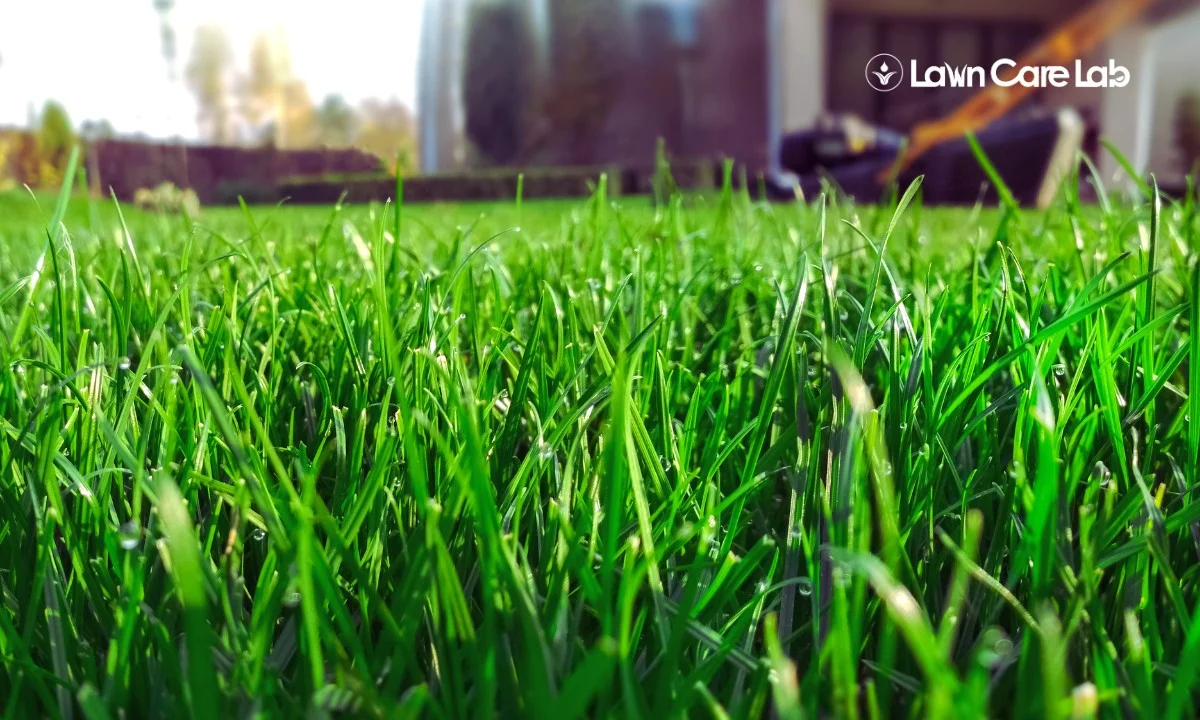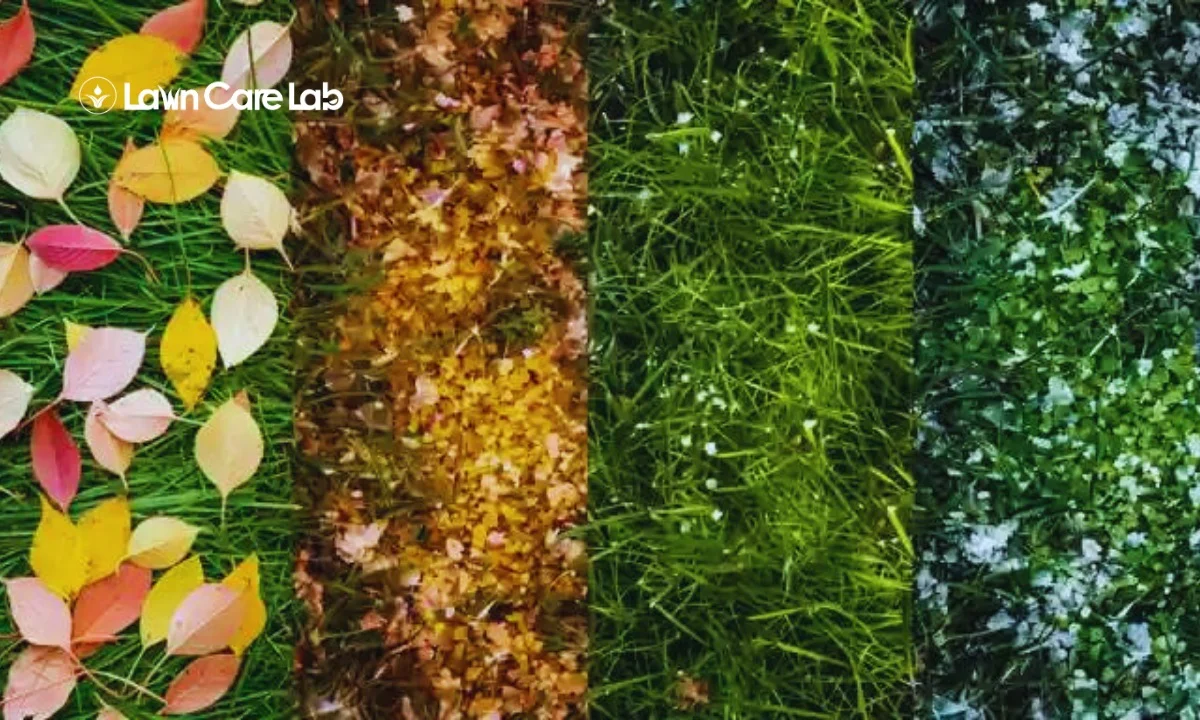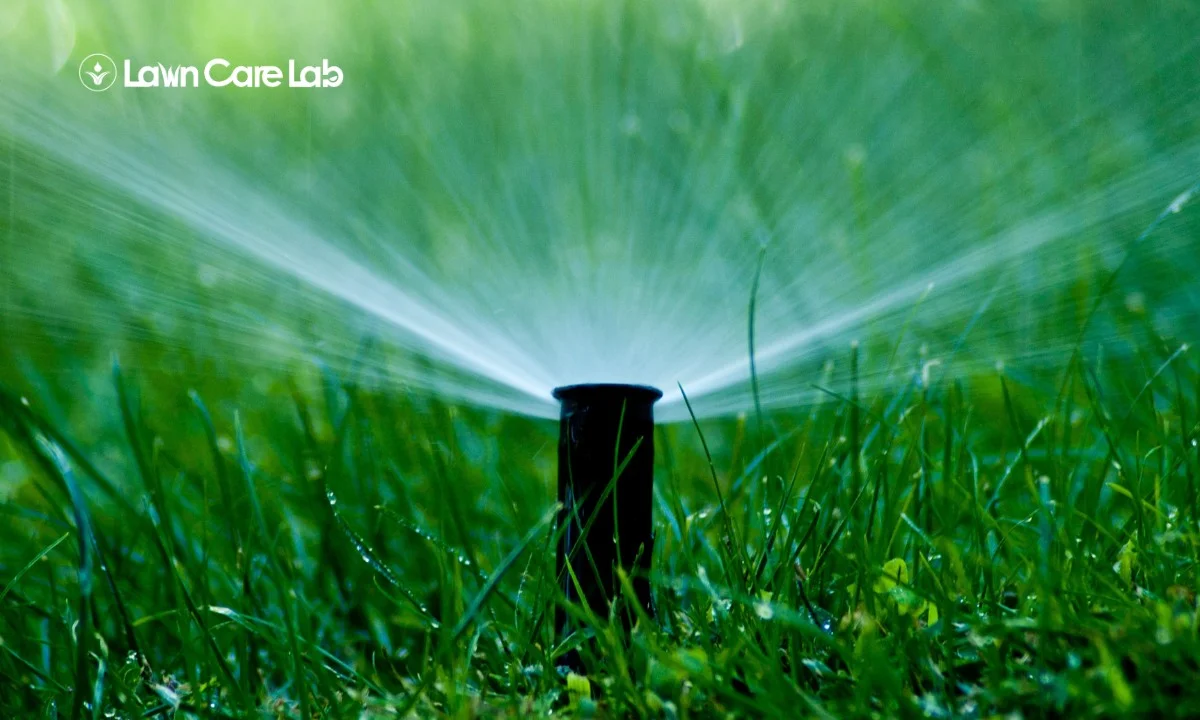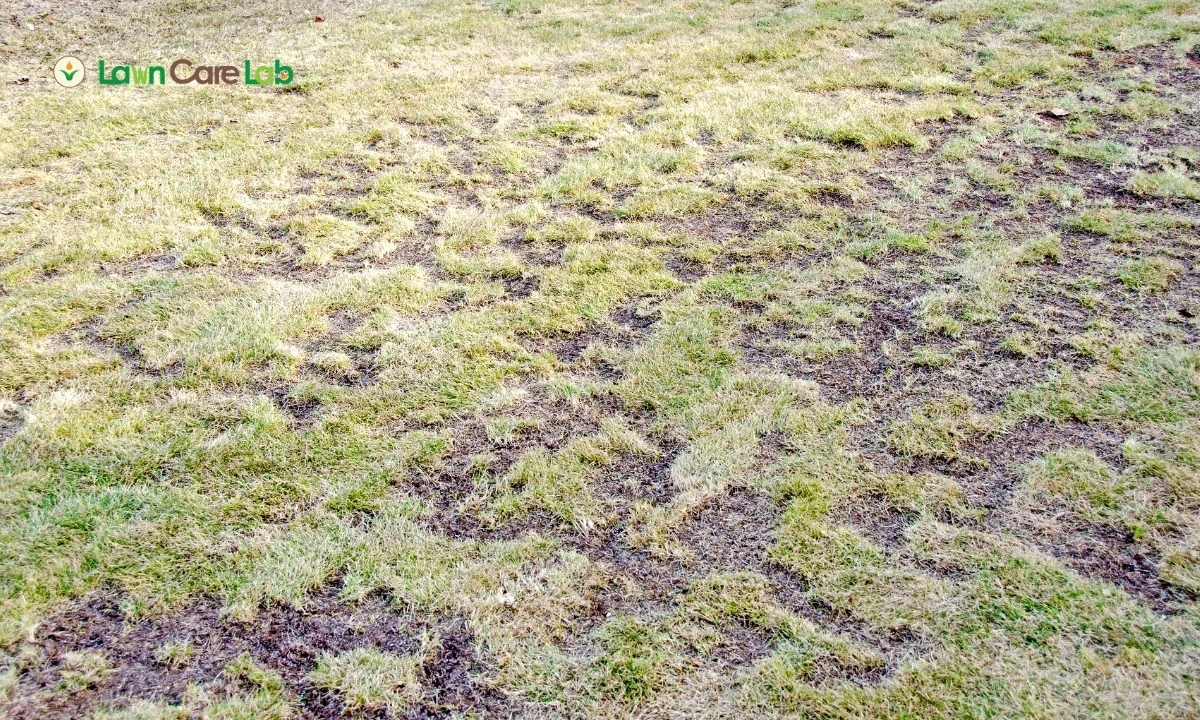Spring is here, and it’s time to breathe new life into your dormant lawn!
This complete guide will teach you pro techniques to revive your lawn in Spring from its winter slumber back into a lush, vibrant green oasis.
Transform your lawn this spring with our strategic tips for fixing hard soil, adding seeds to bare spots, and replenishing nutrients.
Let’s revive bare spots and turn them into vibrant green spaces.
Table of Contents
Assess Lawn Damage in Early Spring
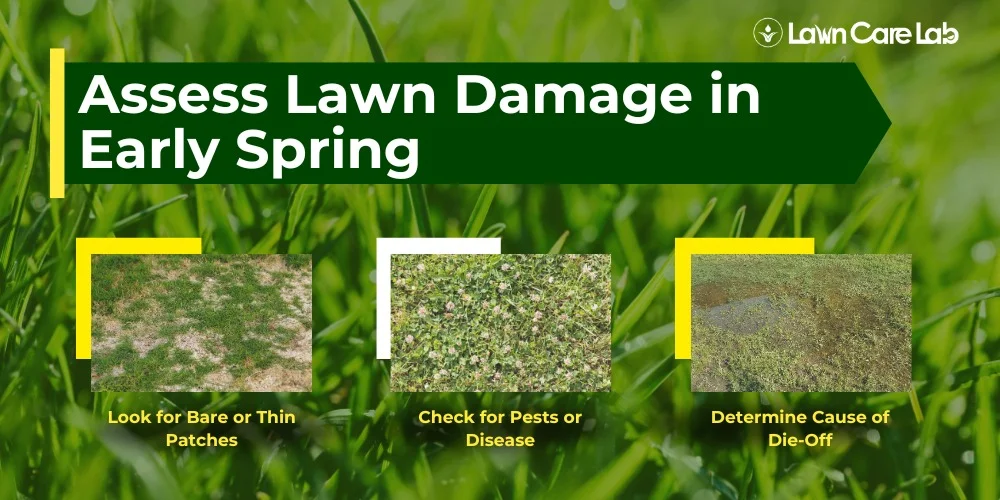
Inspect for bare spots, pests, diseases, and dying areas to transform your lawn into a stunning outdoor area.
Look for Bare or Thin Patches
Check for bare or thin patches in your lawn. It could mean the grass didn’t survive winter.
| Problem | Fix | Fun Side |
|---|---|---|
| Bare Patches | Reseed or add new sod | It’s like giving your lawn a wig! |
| Thin Patches | Increase sunlight & water | Time for grass to do some stretching – reach for the sky! |
| Winter Damage | Add new sod | You’re your lawn’s superhero this spring |
Check for Pests or Disease
Inspect your lawn closely in early spring for bare, thin, or slow-to-green patches.
- Check for signs of grubs, chinch bugs, and fungal issues.
- Map out problematic areas to guide targeted maintenance.
- Overseed and fertilized to revive bare and thin spots.
- Treat pest and disease issues proactively.
Watch for grub tunnels – these pests might be harming your lawn from below!
Early detection of yellow grass or dead patches in your lawn is crucial to fixing any problems, whether it’s a fungus issue or something else.
Determine the Cause of Die-Off
After spotting any pests or diseases, it’s crucial to discover why certain grass parts are dying.
Here’s a simple guide:
- Look for bad drainage. If wateFr stays around too long after rain, we have an issue.
- Review nutrient levels. If your grass is not getting enough food, it’s time to feed it!
- Spot winterkill or shade problems. Does your lawn look dead due to frost or lack of sunlight from trees?
Repair Compacted Soil

It’s time to aerate and add a layer of compost to your struggling lawns to improve your lawn’s health.
Let’s get to work then.
Aerate Lawn
Aerate your lawn in the spring to allow water, oxygen, and nutrients to reach the grassroots better and to prevent dead grass.
For this, rent a machine called a core aerator. Move it across your lawn in different directions. Overlapping is good in this case!
Aerate before major lawn care like overseeding or fertilizing.
For smaller areas, use a garden fork. It can be your tool to save your lawn.
Solving soil compaction issues can help revive your grass in spring. Target early spring when soil is moist but temperatures are cooler.
Apply Compost Topdressing
The next step is to use compost topdressing.
Find some good compost free from sticks, seeds, or any mess that would make your lawn look untidy.
Next, gently spread this compost thinly over the lawn – about 1/4 to 1/2 inch is enough. This puts helpful microbes and nutrients in the soil right where they’re needed.
After that, rake it in so every corner gets some. Watch as this helps soften hard soil while giving your grass a great meal!
Overseed Bare Areas
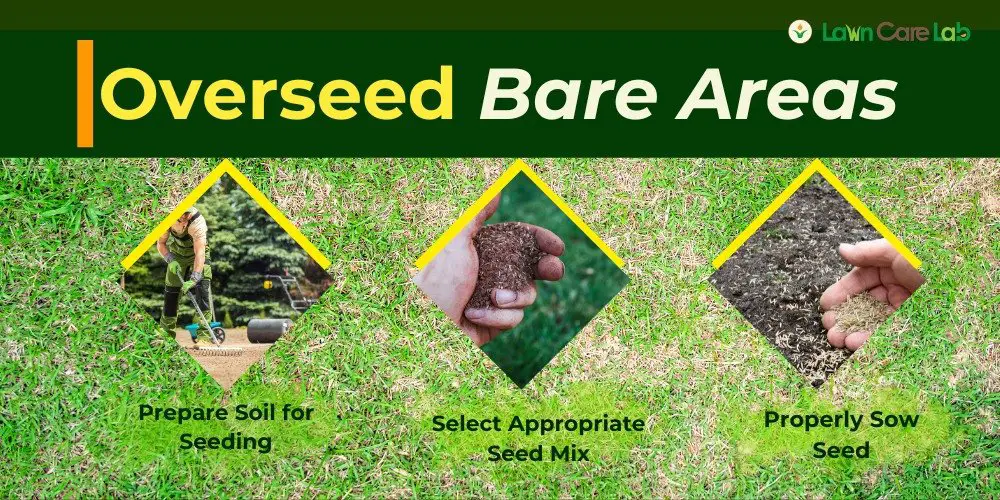
So, you’ve chosen to fix the bare spots in your lawn. We will help you prepare your soil for seed, pick the right seed mix, and plant correctly.
Get ready to work hard and get dirty. Soon, you’ll be enjoying your lush, green lawn!
Prepare Soil for Seeding
Before seeding, you need to prepare your soil well. Make sure the top bit of the soil is loose and free of any rubbish.
- Loosen the Soil: Use a rake to loosen the top 1/4-1/2 inch of the soil.
- Remove Debris: Avoid anything that won’t help your plants grow.
- Use Starter Fertilizer: Apply this as instructed to help the seeds grow.
After this, water the area lightly to dampen the soil.
And there you have it, your soil is ready for planting. So, let’s start growing some grass!
Select Appropriate Seed Mix
Picking the right seed mix for your lawn is very important. Your lawn may need a mix for cooler weather or one that can grow well in the shade.
For lawns that get a lot of sun, choose a full-sun mix. If your lawn is often in the shade, choose a mix that can grow in the shade. You can also get a mix with weed preventers. This can help keep unwanted weeds away from your lawn.
Properly Sow Seed
Properly sowing your chosen seed mix is crucial for good lawn growth.
Here’s how to do it:
- Spread seeds evenly with a drop or broadcast spreader. It’s like magic dust for your lawn!
- Water lightly each day; don’t overdo it. Avoid washing away the seeds and creating a river. Aim for a beautiful lawn.
Gently rake these small seeds into the top quarter inch of soil before watering.
Restore Nutrients
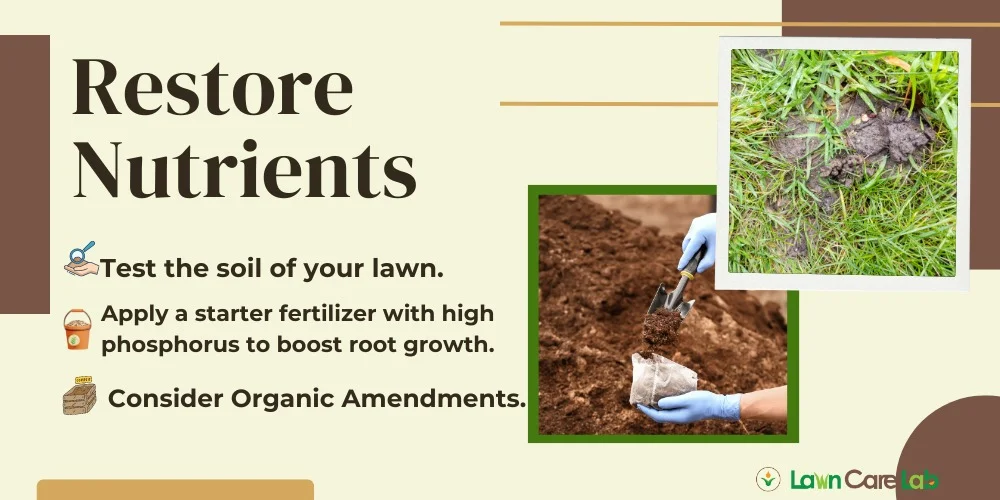
It’s time to find out what’s wrong if your lawn looks sick.
First, test the soil like a doctor’s check-up for your lawn.
Next, use some starter fertilizer as a good breakfast for your grass.
Also, try organic amendments. They’re like a new healthy food for your lawn.
Perform Soil Test
To understand what nutrients your lawn needs, a soil test is necessary.
Here’s the simple process:
- Get a soil testing kit, easy to use and affordable, found at garden stores or online.
- Dig up soil samples from different parts of your yard to get an accurate view of what’s happening below the surface.
- Follow the kit instructions.
Remember, knowing your lawn’s needs makes fertilizing more effective and helps restore its lively spring look.
Apply Starter Fertilizer
Apply a starter fertilizer with high phosphorus to boost root growth, like an energy booster for your lawn, without any negative side effects.
Here’s the simple version. You need to apply this fertilizer twice – first when you’re seeding and then again between 4-6 weeks later. To make it easier, here’s a simple chart:
| When to Apply | Reason |
|---|---|
| During Seeding | To create ideal N-P-K levels for new grass |
| 4-6 Weeks Later | To support growth of existing grass |
Regular care and feedings are key.
After giving your lawn this great fertilizer, consider using organic amendments.
Consider Organic Amendments
Use organic materials like compost, alfalfa meal, worm castings, kelp meal, and synthetic fertilizers to provide slow-release nutrients and improve your lawn.
Here’s a list of organic materials you could use:
- Compost: Your grass can benefit from it.
- Alfalfa Meal: It’s not just for feeding animals.
- Worm Castings: They can make your lawn healthier.
- Kelp Meal: It can give your backyard a unique touch.
Remember to use these organic materials 1-2 times from the end of spring to summer. Your garden will turn into a vibrant green space!
Adjust Watering for Spring Growth
We’ll talk about how to water thoroughly but not too often, increase your watering rate without overdoing it, and even let your soil dry out between waterings.
Water Deeply and Infrequently
Water deeply and infrequently for a strong, healthy lawn that impresses your neighbors.
Here are some tips on how to water properly:
- Soak: Water up to 6 inches deep. It’s like a relaxing day for your grassroots. But too much water can be harmful.
- Take breaks: Let the top inch dry out in between watering. Just like people, grass also needs rest.
- Avoid runoff: A deep soak once a week should be enough.
As your lawn grows faster, water it more often, about 2-3 times a week. Monitor the top 1/2 inch of soil and water when it becomes dry. Think of it as providing snacks to a hungry teenager.
Allow Soil to Dry Between Waterings
Keep your lawn healthy by letting the top layer of soil dry out between waterings. This helps prevent fungus and keeps your grass happy.
Here’s how you can do this:
- Check the Soil: Use a screwdriver to check how wet the soil is 4-6 inches down.
- If the screwdriver goes in easily: Your soil is wet enough.
- If it’s hard to push in: It’s time to water again.
After discussing watering, let’s talk about mowing and care.
Maintain Proper Mowing and Care
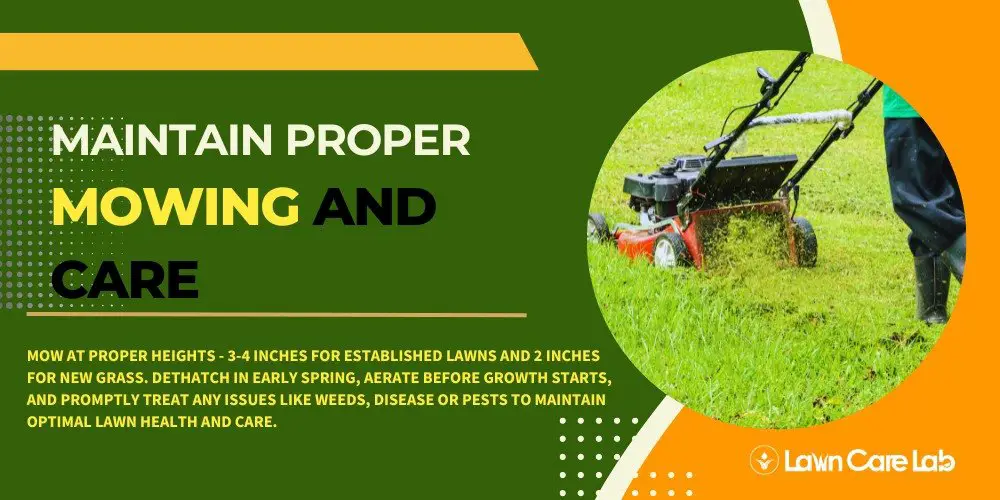
It’s time to care for your lawnmower by mowing at the right height, removing thatch buildup, and fixing any lawn issues.
Mow at the Recommended Height
Mow your lawn at the suggested height for stronger, drought-resistant grass.
Here’s a simple list to remember:
- First Mowing Rule: Mow at 3-4 inches for deep-rooted, drought-resistant grass.
- For New Grass: Let the grass grow to 3 inches, then cut to 2 inches for stronger growth.
Remember these mowing techniques, and your lawn will stay healthy and green!
Remove Thatch Buildup
Remember to remove thatch buildup to let air, water, and nutrients reach your lawn better.
Remove dead grass and debris with a dethatching rake to save lawns from thatch. Be a hero like ‘Thatchinator’!
Aerate your lawn before heavy growth starts. Then celebrate with a walk in your aerator boots for a healthier lawn!
Treat Any Lingering Issues
It’s time to solve any issues in your garden with natural sprays and soil treatments – like being a detective in your backyard.
Here are a few things to watch for:
- Weeds: Dealing with weeds? Use natural weed killers and pull out stubborn ones by hand.
- Disease: Seeing odd colors or patterns on your grass? Use the right natural fungicides quickly.
- Pests: Is your lawn looking full of holes rather than lush? Natural pest control methods should work.
Act quickly before these annoying issues spread faster than chat at a garden get-together!
Conclusion
So, get out there and take charge of your grass. With a little care, your neighbors will soon admire your lawn.
Remember, hard soil is bad, overseeding is your hidden tool, and water is vital!
Now, go ahead and handle your spring lawn care with enthusiasm!
Frequently Asked Questions
What Type of Grass Seed Is Best for Spring Planting?
Choose cool-season types like Kentucky bluegrass, perennial ryegrass, or fescue. They’ll make your lawn green and beautiful quickly!
How Often Should I Water My Lawn After Overseeding in the Spring?
Water your overseeded lawn lightly 2-3 times a day. Keep it damp for new grass growth, but avoid soaking it.
What Equipment Is Necessary for Repairing Compacted Soil?
Loosen hard-packed soil with a garden fork or aerator and use a wheelbarrow to transport compost.
How Can I Determine the Nutrient Deficiencies in My Lawn?
Observe your lawn for signs of nutrient deficiency, like yellow leaves or poor growth. Test the soil to figure out what’s missing.
Is There a Specific Mowing Pattern That Promotes Healthier Spring Growth?
Changing your mowing pattern helps keep your grass healthy and promotes better growth.
- Special Considerations and Techniques for Maintaining Sloped Lawns - July 15, 2024
- How Green Spaces Influence Community Interactions - July 8, 2024
- Lawn Fungal Diseases: Identification and Treatment - July 3, 2024

